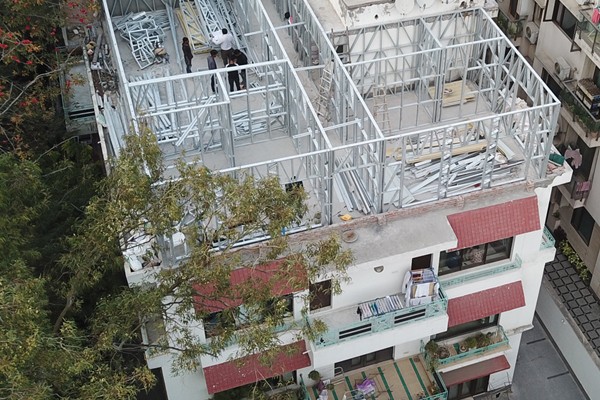In the world of construction, the demand for faster, more efficient, and cost-effective building solutions is constantly growing. Traditional brick-and-mortar structures, while reliable, can be time-consuming, labor-intensive, and resource-heavy. Enter light gauge steel frames (LGSF), light block construction, and portable cabins – innovative technologies reshaping the industry by offering flexible, strong, and sustainable alternatives. But what exactly are these methods, and why are they gaining traction? Let’s dive into this game-changing approach to modern construction.
What is a Light Gauge Steel Frame?
A light gauge steel frame is a construction method that uses thin, cold-formed steel sections to create structural frameworks. Unlike conventional heavy steel structures, LGSF uses lighter, thinner steel, making it more versatile and easier to handle. It is primarily used for non-load bearing walls, interior partitions, and exterior walls in both residential and commercial buildings.
Key Characteristics of Light Gauge Steel Frames:
- Thin but Strong: Made from galvanized steel sheets, typically ranging from 0.5mm to 3mm in thickness, offering high tensile strength.
- Corrosion-Resistant: Treated with protective coatings to resist rust and corrosion, extending the lifespan of the structure.
- Precision Engineered: Manufactured using precise CAD/CAM technologies, ensuring consistent quality and fit.
- Lightweight yet sturdy: Despite being lightweight, LGSF offers impressive structural stability and load-bearing capacity.
How is a Light Gauge Steel Frame Built?
Constructing a light gauge steel frame involves several precise steps, making it a highly efficient and predictable process:
- Design and Planning: The first step is creating detailed architectural designs using CAD software, ensuring every component fits perfectly.
- Fabrication: Steel sheets are cold-formed into specific shapes like C-sections and U-sections, which serve as the frame’s skeleton.
- Assembly: The prefabricated steel sections are assembled on-site using bolts, screws, or welding, depending on the project requirements.
- Integration with Other Systems: LGSF systems are often combined with light block construction for walls and insulation, creating a complete building envelope.
- Finishing Touches: The final steps include adding insulation, cladding, and internal finishes, resulting in a fully functional building.
Benefits of Light Gauge Steel Frames
Using light gauge steel frames offers numerous advantages over traditional construction methods:
- Speed of Construction: LGSF projects can be completed 30-50% faster than conventional buildings, thanks to off-site fabrication and easy assembly.
- Cost-Efficient: Lower labor costs, reduced waste, and shorter project timelines make it a cost-effective choice.
- Design Flexibility: The lightweight nature of LGSF allows for complex architectural designs without compromising strength.
- Sustainability: Steel is 100% recyclable, reducing the environmental impact and supporting green building initiatives.
- Fire and Pest Resistant: Unlike wood, steel is non-combustible and resistant to termites, enhancing building safety.
- Precision and Quality: Factory-made components ensure high-quality construction with minimal defects.
Light Block Construction: A Smart Choice for Modern Buildings
Light block construction combines the efficiency of light gauge steel frames with pre-formed, lightweight concrete blocks. This method not only saves time but also enhances the structural integrity of the building.
Why Choose Light Block Construction?
- Thermal Efficiency: Excellent insulation properties reduce energy costs.
- Strength and Stability: Ideal for seismic zones due to its flexibility.
- Sustainable: Uses less material compared to traditional brickwork.
- Fast Installation: Prefabricated blocks minimize construction time.
Applications:
- Residential complexes
- Commercial buildings
- Temporary or semi-permanent structures
- Warehousing facilities
The Role of Light Block Construction in Modern Building
While light gauge steel frames provide the skeleton, light block construction forms the flesh of a building. Light blocks, typically made from aerated concrete or other lightweight materials, offer excellent thermal insulation, soundproofing, and fire resistance.
Advantages of Light Block Construction:
- Thermal Efficiency: Helps maintain indoor temperatures, reducing heating and cooling costs.
- Sound Insulation: Creates quieter indoor environments, ideal for residential and office spaces.
- Lightweight Yet Durable: Easier to handle during construction while maintaining long-term strength.
- Reduced Foundation Load: Lighter blocks reduce the stress on foundations, making them ideal for high-rise buildings.
Portable Cabins: Flexible Spaces for Modern Needs
In today’s fast-paced world, portable cabins are becoming a popular choice for offices, classrooms, site accommodations, and even tiny homes. Built using light gauge steel frames and light block construction, these portable structures offer unmatched flexibility and durability.
Why Choose Portable Cabins?
- Mobility and Flexibility: Easily relocated as project needs change.
- Cost-Effective: Lower upfront costs and reduced construction time.
- Customizable Designs: Available in a variety of sizes, layouts, and finishes.
- Energy Efficiency: Often designed with insulated walls and energy-efficient systems.
- Low Maintenance: Built to withstand harsh conditions with minimal upkeep.
Future of Construction: Embracing Sustainable Techniques
As construction practices evolve, embracing techniques like light gauge steel framing and light block construction is crucial for reducing environmental impacts. Prefabrication not only ensures quality control but also contributes to sustainable development.
Solvabuild’s innovative approach reflects a forward-thinking vision, helping shape the future of construction in India. Whether you’re looking for resilient portable cabins or energy-efficient buildings, light gauge steel frames are setting new benchmarks in durability and sustainability.
Final Thoughts: Building a Greener Tomorrow
Adopting light gauge steel frames and light block constructions is more than just a trend—it’s a necessity. As we strive for a sustainable future, companies like Solvabuild are leading the way by creating versatile, eco-friendly structures that blend innovation with responsibility.
By choosing smarter, greener building methods, we can reduce our environmental footprint while creating resilient, adaptable spaces. It’s time to build not just for today but for a better tomorrow.



